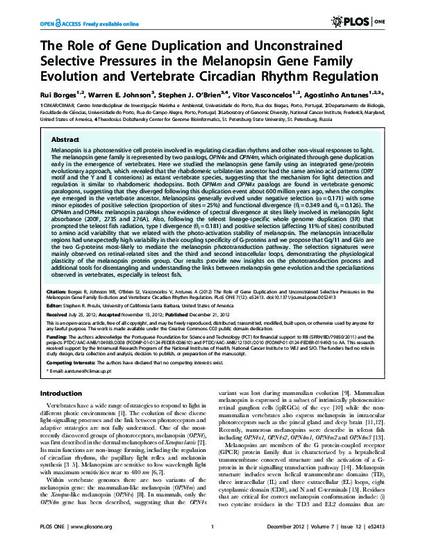
Melanopsin is a photosensitive cell protein involved in regulating circadian rhythms and other non-visual responses to light. The melanopsin gene family is represented by two paralogs,OPN4x and OPN4m, which originated through gene duplication early in the emergence of vertebrates. Here we studied the melanopsin gene family using an integrated gene/protein evolutionary approach, which revealed that the rhabdomeric urbilaterian ancestor had the same amino acid patterns (DRY motif and the Y and E conterions) as extant vertebrate species, suggesting that the mechanism for light detection and regulation is similar to rhabdomeric rhodopsins. Both OPN4m and OPN4x paralogs are found in vertebrate genomic paralogons, suggesting that they diverged following this duplication event about 600 million years ago, when the complex eye emerged in the vertebrate ancestor. Melanopsins generally evolved under negative selection (ω = 0.171) with some minor episodes of positive selection (proportion of sites = 25%) and functional divergence (θI = 0.349 and θII = 0.126). The OPN4m and OPN4x melanopsin paralogs show evidence of spectral divergence at sites likely involved in melanopsin light absorbance (200F, 273S and 276A). Also, following the teleost lineage-specific whole genome duplication (3R) that prompted the teleost fish radiation, type I divergence (θI = 0.181) and positive selection (affecting 11% of sites) contributed to amino acid variability that we related with the photo-activation stability of melanopsin. The melanopsin intracellular regions had unexpectedly high variability in their coupling specificity of G-proteins and we propose that Gq/11 and Gi/o are the two G-proteins most-likely to mediate the melanopsin phototransduction pathway. The selection signatures were mainly observed on retinal-related sites and the third and second intracellular loops, demonstrating the physiological plasticity of the melanopsin protein group. Our results provide new insights on the phototransduction process and additional tools for disentangling and understanding the links between melanopsin gene evolution and the specializations observed in vertebrates, especially in teleost fish.
Available at: http://works.bepress.com/stephen-obrien/636/

This is an open-access article, free of all copyright, and may be freely reproduced, distributed, transmitted, modified, built upon, or otherwise used by anyone for any lawful purpose. The work is made available under the Creative Commons CC0 public domain dedication.